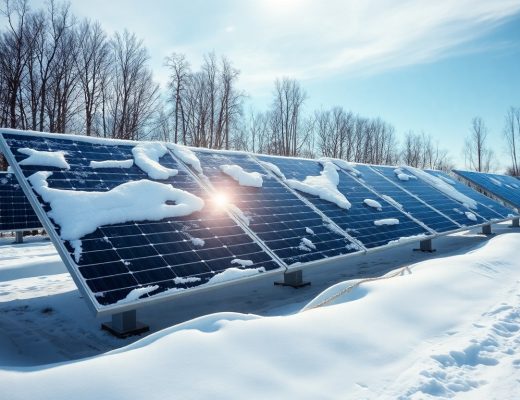A hybrid solar system combines the advantages of both solar photovoltaic (PV) panels and traditional power sources to optimize energy generation for your home. By integrating battery storage and grid connection, this system allows you to harness renewable energy while ensuring a reliable power supply, even during outages. You can benefit from reduced energy bills and increased energy independence, making it a smart investment for your household. In this post, you will learn how a hybrid solar system operates and the necessary components that contribute to its efficiency.
Understanding Hybrid Solar Systems
To grasp how hybrid solar systems function, you need to recognize that they blend conventional energy sources with renewable energy, specifically solar power. This innovative approach allows you to enjoy the benefits of solar energy while maintaining a reliable connection to the grid or backup generators, ensuring that your energy needs are met even during low sunlight conditions.
Definition of Hybrid Solar Systems
Behind the term “hybrid solar system” lies a solution that integrates solar panels with existing energy sources, such as the grid or battery storage. This combination offers you flexibility in managing energy consumption and maximizes the use of renewable energy, resulting in lower electricity costs and reduced environmental impact.
Key Components
The primary elements that make up a hybrid solar system include solar panels, an inverter, a battery storage system, and a grid connection. These components work together to optimize energy usage and storage, allowing you to harness solar power during the day and utilize stored energy or grid power when needed.
Solar panels capture sunlight and convert it into electricity, which is then managed by an inverter that transforms the direct current (DC) into usable alternating current (AC) for your home. The battery storage system plays an important role by storing excess energy generated during sunny periods, enabling you to use this energy when sunlight isn’t available. Lastly, the grid connection serves as a backup source of power when your solar energy production is insufficient, ensuring you always have access to electricity. Together, these components create a resilient and efficient energy solution for your needs.
Benefits of Hybrid Solar Systems
If you’re looking for a sustainable energy solution, hybrid solar systems offer numerous benefits. They combine the advantages of solar power with traditional energy sources, which helps to enhance efficiency and reliability. You have the flexibility to harness solar energy while still relying on the grid when necessary, ensuring that you never run short on power, regardless of weather conditions or systemic outages.
Energy Independence
Around your home, energy independence becomes a reality with hybrid solar systems. By reducing reliance on the grid and utilizing energy generated from the sun, you can increase your self-sufficiency. This independence allows you to hedge against fluctuating energy prices and supports the adoption of renewable energy, fostering a greener environment while providing you with peace of mind.
Cost Savings
Above all, cost savings are a significant advantage of implementing a hybrid solar system. By generating your own electricity, you can decrease your monthly energy bills and take advantage of incentives such as tax credits and rebates, further lowering the initial investment. This combination can lead to substantial long-term savings.
Considering the rising costs of energy and potential future price volatility, investing in a hybrid solar system can lead to substantial financial relief over time. By producing your own energy and relying less on costly grid electricity, you position yourself to benefit from predictable energy costs. Additionally, with net metering policies, you might even earn credits for any excess energy produced, further enhancing your savings potential.
How Hybrid Solar Systems Operate
Now, understanding how hybrid solar systems operate is imperative for maximizing your energy efficiency. These systems seamlessly combine solar power generation with traditional energy sources, such as the grid or backup generators. By leveraging solar panels, an inverter, and energy storage solutions, hybrid systems allow you to manage your energy consumption effectively. This not only reduces your reliance on the grid but also positions you to benefit from energy savings in the long run.
Integration of Energy Sources
Around hybrid solar systems, the integration of various energy sources is vital for optimal performance. These systems typically connect solar panels, energy storage batteries, the electrical grid, and backup generators into one cohesive network. This integration allows you to switch between solar power and grid electricity seamlessly, ensuring you have a consistent and reliable energy supply while reducing fuel costs and environmental impact.
Energy Storage Solutions
Along with efficient solar energy generation, energy storage solutions play a significant role in hybrid systems. By incorporating batteries, you can store excess energy produced during sunny days for use at night or during cloudy periods. This enhances your energy independence and ensures you have backup power whenever you need it.
Energy storage solutions are key components that enhance the functionality of your hybrid solar system. By investing in high-quality batteries, you can store surplus energy generated during peak sunlight hours, allowing you to utilize that stored energy during high-demand periods or at night. This not only maximizes your energy efficiency but also adds a layer of reliability in case of grid outages. Incorporating advanced battery technology ensures quicker charging, longer lifespan, and optimal performance, giving you peace of mind and control over your energy consumption.
Installation Considerations
Despite the appeal of hybrid solar systems, you must take into account various installation considerations to ensure optimal performance. This involves selecting the right location for your solar panels, choosing compatible components, and adhering to local regulations. Each factor plays a significant role in how efficiently your hybrid system will operate, and thorough planning will help you make the most out of your investment.
Site Assessment
Against all odds, a comprehensive site assessment is vital to the successful installation of your hybrid solar system. Factors such as shade from nearby trees or buildings, roof orientation, and the amount of sunlight your property receives will significantly impact the energy production of your system. By properly evaluating these elements, you can maximize energy generation and ensure that your system functions effectively.
System Sizing
Above all, determining the right size for your hybrid solar system is vital to meet your energy needs. This process involves calculating your average energy consumption and factoring in the capabilities of your solar panels and battery storage. An accurately sized system not only prevents over or under-investment, but ensures that your energy demands can be comfortably met.
Plus, adequate system sizing allows you to maximize your return on investment. A well-sized hybrid system will generate enough power to fulfill your energy needs, while also potentially reducing your reliance on the grid. By working with an experienced solar installer, you’ll be able to determine the optimal capacity of solar panels and battery storage that suits your lifestyle, enabling you to harness energy efficiently and effectively.
Maintenance of Hybrid Solar Systems
Once again, maintaining your hybrid solar system is key to ensuring its performance and longevity. Regular maintenance not only optimizes energy output but also prevents unexpected failures that could hinder your energy independence. Minimal effort in upkeep can lead to significant long-term gains, making it crucial for you to stay informed and proactive in your maintenance routine.
Routine Checks
On a regular basis, you should conduct routine checks to monitor the health of your hybrid solar system. This includes inspecting solar panels for any debris or dirt, checking connections for any signs of wear, and ensuring inverters are functioning properly. Regular maintenance allows you to catch potential issues before they escalate, ensuring your system operates efficiently.
Troubleshooting Common Issues
Among the most common issues with hybrid solar systems are inverter failures, unclear panels, and poor battery performance. These issues can happen due to various factors, including environmental conditions or equipment wear. Addressing these problems quickly is crucial to maximize the efficiency of your energy system.
Also, troubleshooting common issues involves checking your system’s performance data and identifying anomalies such as reduced energy output or unexpected discharges. You may need to consult your system’s manual or seek professional assistance if the problem persists. Keeping a close eye on these factors allows you to maintain optimal performance and extend the lifespan of your hybrid solar system.
Common Myths about Hybrid Solar Systems
After exploring hybrid solar systems, you may encounter various myths that can cloud your understanding of their effectiveness. Many believe that hybrid systems are too complex or that they don’t provide significant energy savings. Others think these systems are only for off-grid living. By addressing these misconceptions, you can make better-informed decisions about whether a hybrid solar system is right for your energy needs.
Misconceptions Debunked
On closer examination, you will find that hybrid solar systems are designed for convenience and accessibility, not complexity. They can actually lower your energy bills, allowing you to utilize both the grid and renewable energy from solar panels. Additionally, they’re suitable for homeowners who want the benefits of solar energy without going completely off-grid.
Realities of System Performance
To help you understand the capabilities of a hybrid solar system, it’s important to focus on its performance during different conditions. These systems are designed to seamlessly switch between solar power, battery storage, and grid electricity to ensure a steady energy supply. This adaptability enhances reliability and efficiency, even during cloudy days or power outages.
Hence, you can expect your hybrid solar system to perform consistently, regardless of external conditions. Its ability to store excess energy generated during peak sunlight hours means you can use that energy later when it’s needed most. This hybrid approach not only maximizes energy use but also provides a safety net during power disruptions, most importantly allowing you to enjoy energy independence and cost savings over time.
Conclusion
Following this understanding of how a hybrid solar system works, you can leverage the benefits of both solar energy and battery storage for your energy needs. By efficiently combining solar panels with batteries and a backup generator, you can optimize your energy usage, reduce your electricity bills, and enhance your energy independence. This integrated approach not only ensures continuous power supply even during outages but also contributes to a more sustainable lifestyle, allowing you to make informed decisions for your home or business. Embrace the future of energy with a hybrid solar system that fits your needs.




